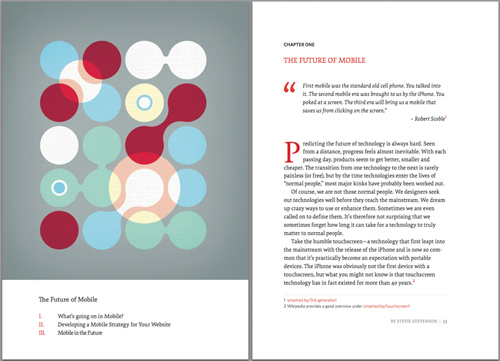Maybe you’re an executive who doesn’t truly understand all the forces at play within the mobile phone market who needs a definition of responsive design along with associated justifications for its use. Or, you might be a user experience designer who simply wishes to create that cool, intuitive webpage, but who can’t quite navigate all of the potholes created by proliferating browsers and varying screen resolutions. Perhaps you’re a marketeer (not to be confused with a musketeer) who must make market-specific development choices with a UX compass. Whatever your reason for picking up The Mobile Book by Smashing Magazine (and various authors who each produced a chapter) you’ll find a timely and accesible guide for navigating the complex world of mobile design.
The quasi-textbook begins with a description of the current state of affairs in the mobile world. No, not your run-of-the-mill opining about how one, large fruit (that will remain nameless, of course) will roll over the competition, but a fact-based analysis of the various hardware, network, and OS choices out there. This foundation debunks any naysayers who believe a communization of practices and software is imminent, and sets the stage for the remainder of the book.
Chapter 1 concludes with many rich pages filled with crucial advice on beginning the process of development paired with associated justifications. For instance, the author suggests buying several phones at the beginning to establish a “Device Lab,” or test bed, for your design. Yeah, seriously expensive for the little guys, but he immediately defends the overhead with multiple examples—like the existence of a native “back” button for some operating systems (e.g. Blackberry, Android) which can be confusing to users if a secondary button is provided within the design.
The next section attempts to prognosticate the future of mobility. Only time will tell if this is as accurate as Morgan Robinson’s foretelling in the 1898 novel, Futility—about the world’s largest steamship (prophetically named, The Titan) hitting a disastrous iceberg—or closer to the apocalyptic anti-soothsaying in 1999 regarding the Y2K non-event. In other words, it may be a crystal ball, or it may be a marble ball. Either way, this chapter reminds me why I tell my graduate students that there’s a fantastic and wonderfully empowering reason why there’s no textbook for Human-Machine Interface (HMI) design: because it is ever-evolving by definition. The minute you predict the dot matrix will be replaced by TFT displays, those are being replaced by X, Y & Z.
That said, the content of this chapter provides some useful likelihoods if you are that marketeer looking to color-in your roadmap. The geek in me wanted more graphs and data that extrapolated into the coming years, but the content was interesting nonetheless. I’m not a big believer in smart fridges (see UX in Practice) or some of the other connectivity possibilities, but I fully agree with the author’s supposition that additional enablers (like food-sensors or RFID/NFC’s to suggest recipes for leftovers and shopping-list fodder) might propel superfluous technology into must-haves.
The next three sections provide a comprehensive guide to responsive web design (RWD). For any UX folk who have been cave-dwelling the past couple of years, these are websites that adjust to the size of the browser window by intelligently shrinking and repositioning the identical content (see Emeril’s website as a good example; shrink your browser window and watch the UX adapt). In this fashion, companies may “… have one version to maintain, one version to budget for, and one version of consistent content for users.” Here the book transforms from a high-level compass to a pragmatic guide for the UX practitioner, delving into the nitty-gritty dos and don’ts of future proofing, key mistakes to avoid, design patterns to consider, and optimization tips to contemplate.
If you’re an executive, you may skim this section as long as you capture these three key points: 1) “There’s no time like the present to abandon static ways of thinking about how layout and content interact,” 2) “…57% of users who had a problem with a website on their mobile phone, including slow loading, wouldn’t recommend that website or service; 46% wouldn’t return,” and 3) “… there is no substitute for being in control of your own destiny.” If you are the UX architect, these informative chapters should become your Even-Newer Testament.

The final section delves into designing for touch on mobile devices. In maybe the most philosophical portion of the entire book—with reflective truths that I would’ve preferred to see at the front of the book—one of the authors essentially says the previous ten score of pages don’t pose the biggest design challenges.
“What I’ve realized is that all of these challenges are technical in nature. They are all resolvable problems—problems that we’ll eventually work out,” he writes. “The bigger challenge is one that can’t be solved in code. This challenge will need to be solved collectively, in our minds. We carry with us personal, intelligent technology that’s always connected and always with us. These devices will inevitably continue to shape how we think and behave, transforming the way we access information and interact with the world around us. So, how do we go about recognizing the huge potential of these small devices that we hold in the palm of our hand?”
Thereafter, the author reveals secrets to designing within the Land of Non-Constructs: No such thing as a static canvas. My favorite among them is the advice to avoid static deliverables, as I believe paper specifications are the scourge of UX. Modeling and prototyping a design hypothesis, he says, avoids the telephone game from being played by the design team, with individuals adding missing pieces into a 2D paper mess. “Until your stakeholders or test users actually interact with a prototype of some sort in their hands, most of the feedback you’ll gather will be based on how people think users will act, not on how they will actually act.”
Such assertions allow for interactive validation on various mobile platforms. All 16 suggestions are categorized by Ideation, Behavioral Prototyping, High-Fidelity Prototyping, Prototyping Style, and Content Planning. Again, the nerd in me wanted statistics and data to support these theories (… modeling a UI is 75% more efficient per Abowd et al, 2004), but I learned several tips that I will assuredly use in my next design project. And yes, there were some conflicting recommendations between the different authors of different chapters (should we design for one-handed operation or not??), but all in all the reader walks away significantly wiser.
I highly recommend this book to both the blossoming and the experienced UX designer. The various voices of different authors breathe fresh narrative air that carries diverse-and-deep domain knowledge along in a cohesive story about how to harness the chaos of our ever-evolving world into a mobile-UX delight.
Consider the lessons in this book a whopping set of New Year resolutions.







